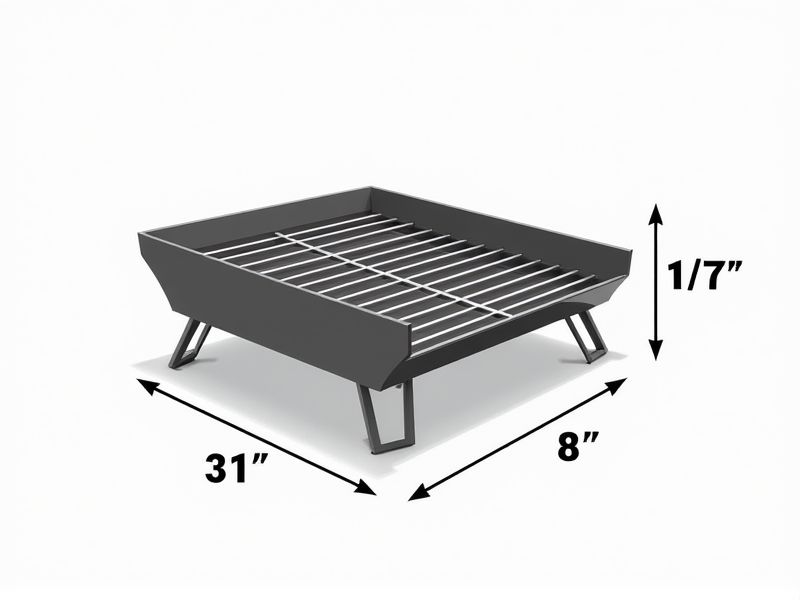
When choosing a grill, it's helpful to know that standard dimensions typically range from 24 to 36 inches in width for the main cooking area. For example, a common family-sized gas grill might measure around 30 inches wide, 20 inches deep, and about 45 inches tall (including the lid and stand). These dimensions provide enough cooking space for 15 to 20 burgers, making them suitable for most backyard gatherings. Always check the specifications, as sizes can vary based on brand and whether the grill is free-standing, built-in, or portable.
Width
The standard width for most residential grills typically ranges from 24 to 36 inches, providing ample cooking space for various food types. Models with a width of 30 inches are often recommended for average-sized patios and gatherings, accommodating up to 10 burgers simultaneously. For commercial applications, widths can extend to 48 inches or more, allowing for larger capacities and higher output during peak service periods. Consider your outdoor cooking needs carefully to choose the grill width that best fits your lifestyle and entertaining habits.
Height
The standard grill height typically ranges from 30 to 36 inches, providing an ergonomic cooking experience. This height accommodates a variety of users and cooking styles, ensuring comfort while flipping burgers or searing steaks. For outdoor kitchen setups, maintaining this height is essential to optimize space and ensure accessibility. Your choice of grill height can significantly impact the overall cooking efficiency and user satisfaction.
Depth
The standard for grill depth typically ranges between 18 to 24 inches, ensuring adequate space for cooking various types of food evenly. A depth of 20 inches is often considered optimal for balancing heat distribution and cooking efficiency. This allows for grilling larger cuts of meat while maintaining the ability to manage flare-ups effectively. If you prioritize this aspect, investing in a grill with adjustable depth can enhance your cooking experience.
Bar Spacing
The spacing between grill bars, typically ranging from 0.5 to 3 inches, significantly impacts cooking efficiency and food flavor. Closer bar spacing provides better heat retention, ensuring even cooking and preventing smaller food items from falling through. On the other hand, wider bar spacing allows for unique grill marks and enhanced smoke flow, which can infuse deeper flavors into larger cuts of meat. Choosing the right bar spacing based on your grilling preferences can optimize your overall barbecue experience.
Material Thickness
The material thickness of a grill significantly impacts its durability and heat retention, often determined by gauge numbers, with a lower gauge indicating a thicker material. High-quality grills typically feature stainless steel or cast iron constructions, with thicknesses ranging from 1.5mm to 3mm, providing excellent heat conductivity and longevity. A grill with thicker materials, such as 3mm stainless steel, can enhance cooking performance by achieving consistent temperatures and preventing warping over time. When choosing a grill, consider how the material thickness will affect your cooking experience and the grill's overall life span.
Opening Size
The grill's opening size significantly impacts heat circulation and cooking efficiency, typically ranging from 2 to 6 inches in diameter for optimal airflow. A larger opening enhances heat distribution, allowing for even cooking across the surface and reducing hotspots. Conversely, a smaller opening can result in concentrated heat, ideal for searing but requiring more frequent monitoring. When selecting a grill, consider the intended cooking style and the size of the opening to achieve the best results for your culinary creations.
Grid Pattern
The grid pattern on a grill enhances heat distribution and cooking efficiency, allowing for more even grilling of your food. Traditional grills typically feature spaced horizontal and vertical bars, creating a 1-inch square design that ensures uniform contact with meat and vegetables. This design not only achieves attractive grill marks but also helps to minimize food sticking, facilitating easier flipping and removal. For optimal results, aim for a grill temperature between 400degF and 500degF to maximize flavor and achieve perfect sear marks on your favorite dishes.
Weight Capacity
When selecting a grill, weight capacity plays a crucial role in determining its performance and durability. A grill with a weight capacity of at least 400 pounds guarantees stability, ensuring that it can support heavier cooking materials and withstand regular use. High-quality grills often feature sturdy materials like stainless steel, which enhance both weight limit and longevity. Your cooking experience can significantly improve with a robust grill that handles your culinary creations with ease and confidence.
Clearances
Grill clearances are essential for optimal performance and safety, requiring a minimum distance of 36 inches from flammable materials. For gas grills, maintain a minimum of 24 inches clearance between the grill and any structures. An adequate space allows proper airflow, reducing the risk of overheating and fire hazards. Regular inspections and adjustments to these clearances can enhance your grilling experience and prolong the life of your equipment.
Corner Radius
The corner radius of a grill significantly impacts both its cooking efficiency and safety. Typically, a radius of 1 to 3 inches is ideal, allowing for even heat distribution while reducing the risk of food sticking. Grills designed with a larger corner radius often enhance your overall cleaning experience, as food debris is less likely to accumulate in sharp edges. Properly considered corner radii can improve user experience, making grilling more enjoyable and effective.
